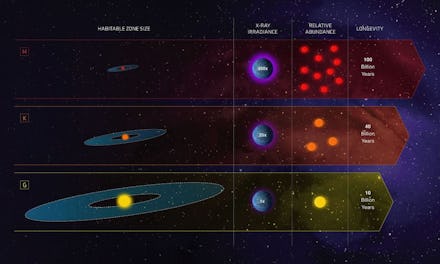One of the most common stars in the galaxy could hold the key to finding life in space

Red dwarfs, or small, relatively "cool" stars, are some of the oldest celestial objects in space and the most common type of star in the Milky Way. As such, scientists have had plenty of chances to study and investigate them. They're also integral when it comes to researchers seeking out planets that could potentially support life. As the story goes, exoplanets found orbiting red dwarfs have typically been thought to feature habitable zones that could indeed allow for some type of life to thrive. But now, according to emerging research, orange dwarf stars (also known as K stars) could actually be more accommodating to life.
Researchers are now suggesting that, after 30 years of studying exoplanets, orange dwarfs could be more hospitable when it comes to hosting life for several reasons: they're more stable, burn for billions of years, are a lesser source of radiation, and are more abundant in the universe than stars like our sun (colloquially known as a G star or yellow dwarf star). That means if one happened to die out eventually, there would most likely be another to take its place.
"The K stars, especially the warmer ones, have the best of all worlds," said Villanova University astronomer Edward Guinan in a NASA statement. "If you are looking for planets with habitability, the abundance of K stars pump up your chances of finding life."
Orange dwarfs are also quite old, in comparison to our sun. Scientists use them to help find planets, because their light is a bit dimmer than the sun our solar system orbits around, making it easier to spot planets when they cross in front of an orange dwarf. There's also less gravitational interference to deal with as well, because an orange dwarf's mass is less than our sun. They're the total package when it comes to seeking out habitable planets.
That's why Guinan is teaming up with Villanova astronomy colleague Scott Engle to put together a special program meant to generate additional data about K stars as well as G stars like our own sun. The program, called "GoldiloKs," is meant to help gather additional information about both K and G stars, including how much radiation they give off, how old they are, and how fast they rotate.
The program is utilizing data from various instruments, such as the Hubble Space Telescope, Chandra X-ray observatory, and the European Space Agency's XMM-Newton satellite. In the future, NASA's as-yet-completed James Webb Space Telescope will be a good candidate for offering additional insight on K stars when it launches in 2021.
While there's still plenty that scientists don't know when it comes to orange dwarfs at this point, current data certainly points to some very useful insights that could make them worthy contenders of sustainable life in the future. We aren't quite there yet, but the research alone is enough to get excited for – especially if you're one who keeps your eyes to the skies.